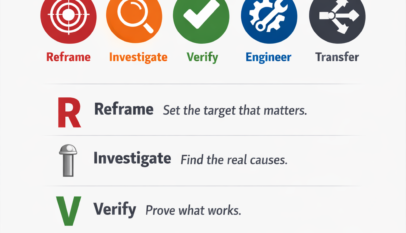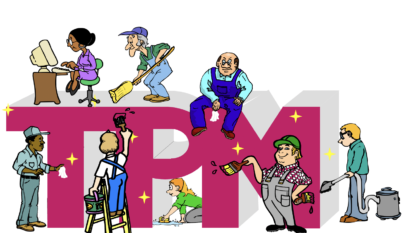Before embarking on the 7 Steps, everyone at every level, including managers from the top echelon right down to front-line supervisors, in all departments concerned, should be given comprehensive training in how the TPM program will be rolled out, and the activities involved. Departmental and area managers from the production department and all other departments concerned (Maintenance, Design, Production Engineering, Personnel, General Affairs, Finance, etc.) should hold a series of meetings and arrive at a full consensus about the help and cooperation the production department needs from the other departments.
Organize teams at every level
It is also crucial to manage the Autonomous Maintenance program by means of what in TPM is called an ‘overlapping small-group organization’, in which everyone belongs to a team, and each team leader is in turn a member of a team or committee at the next higher organizational level. It is important to ensure that team leaders are people who are also in leadership positions in the company’s regular organizational structure. The overlapping small-group organization supplements the line-based organization. Besides allowing the people on the lines to exercise their initiative, it also ensures that the Autonomous Maintenance activities are carried out and managed in an unconstrained, open-minded atmosphere, with teams playing appropriate roles at each hierarchical level.
Line TPM teams should be led by line team leaders. If a team feels unmanageably large, it should be split into sub-teams or mini-teams, each with about half a dozen members. The team leaders at each level form a crucial link to the groups above and below them. The whole system is interconnected and includes everyone in the organization. To make it run properly, a special TPM Office attached to the organization’s TPM Promotion Committee is established, specialist sub-committees are set up as necessary, and TPM champions may be assigned to teams at each level of the organization, to help lead the program effectively.
Autonomous Maintenance needs hands-on management
It is essential to make everyone aware that all Autonomous Maintenance activities are ‘real work’, part of the job itself, and not some extra imposition. Managers are sometimes reluctant to intervene in team activities, reasoning that because Autonomous Maintenance is supposed to be self-managed, it is not part of the job proper, and should be left to the discretion of the operators. This is not the case.
Autonomous Maintenance is an integral part of the work performed within the existing management structure, and its control should not be handed over to the teams in the name of autonomy. It is managers’ responsibility to roll up their sleeves and show everyone what can be done. They need to get their hands dirty and lead the way since this will encourage everyone else to get fully involved in carrying out all the daily maintenance tasks needed to keep the equipment in good order. They must also lead from the front by actively promoting improvement activities based on the established maintenance routines. Managers should understand that in carrying out these activities, they are fulfilling their work responsibilities.
This requires an organizational structure that allows bottom-up as well as top-down communication and keeps the focus on practical activity, rather than theory or methodology. The approach must always be for managers to find out for themselves, through hands-on experience, what each step is about, provide the right environment for the program to flourish, and set an example for others to follow. Only by doing this will they be able to progress the Autonomous Maintenance program according to plan.


















